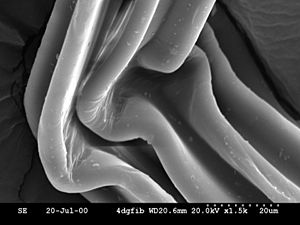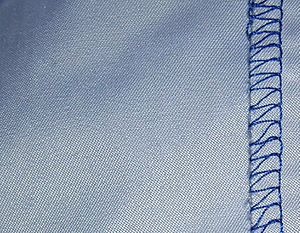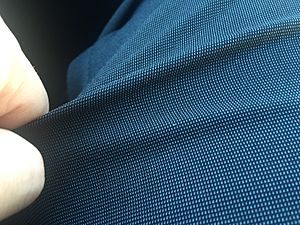Polyester facts for kids
Polyester is a type of polymer, which is a very long chain of tiny repeating chemical units. Think of it like a long train made of many identical cars! These chains contain a special chemical link called an ester. The most common type of polyester you'll hear about is called polyethylene terephthalate, or PET for short.
Polyester can be found naturally, for example, in the waxy coating on plant leaves called cutin. But most polyester we use is made by people (synthetic). Some natural polyesters and a few synthetic ones can break down naturally over time (they are biodegradable). However, most man-made polyesters do not break down easily.
You see polyester everywhere, especially in clothes. Polyester fibers are often mixed with natural fibers like cotton. This creates a fabric that is strong, doesn't wrinkle easily, resists tears, and shrinks less. Clothes made with polyester are also good at resisting water, wind, and general wear and tear compared to fabrics made from plants. But remember, polyester can melt if it gets too hot or catches fire.
Sometimes, polyester fabrics are given new names to make them sound like natural fabrics, or even better. For example, "China silk" is actually 100% polyester that looks and feels a bit like real silk.
Contents
What is Polyester Used For?
Polyester is a very useful material! It can be made into thread or yarn. When these are woven together, they create synthetic fabrics. These fabrics are often used to make many everyday items:
- Shirts, trousers, and jackets
- Hats
- Bedding, like sheets and blankets
- Furniture coverings
Polyester fibers are also great for filling things. They are used as soft cushioning in pillows, comforters, and the padding inside furniture. Because it's good at keeping heat in, polyester is also used in curtains to help insulate windows. You might even find it in some types of carpet!
Beyond clothes and home items, strong polyester fibers, yarns, and ropes are used in industrial products. This includes things like tires and safety belts in cars.
The Chemistry of Polyester
As we mentioned, polyester is a type of polymer. This means it's a very large molecule made up of many smaller, repeating units. These units are linked together by a special chemical bond called an ester functional group. There are many different kinds of polyesters, but the one you'll hear about most often is polyethylene terephthalate (PET).
You can find polyesters in nature, like the protective waxy layer on plant leaves. But most polyesters are made in factories. These man-made polyesters are usually thermoplastics, which means they can be melted and reshaped when heated.
How is Polyester Made?
Most polyesters are made through a process called a "polycondensation reaction." This is a fancy way of saying that many small chemical pieces (called monomers) join together to form a long chain (the polymer). When these small pieces connect, they often release a tiny molecule of water. To make sure the long polyester chain forms correctly, this water needs to be removed as the reaction happens.
Images for kids
See also
 In Spanish: Poliéster para niños
In Spanish: Poliéster para niños






